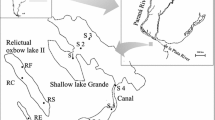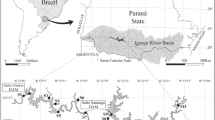Abstract
Alpha, beta and gamma are three components of species diversity. Knowing these attributes in floodplain lake phytoplankton communities is vital when selecting conservation areas. Species diversity is commonly used with other taxonomic groups, but rarely with phytoplankton. We compared the number of phytoplankton species (alpha diversity) from 21 Middle Araguaia River floodplain lakes in the 2000 and 2001 rainy and dry seasons. From these samples we estimated complete survey species richness (gamma diversity), quantified differences in species composition between lakes (beta diversity) and assessed the influence of abiotic variables on beta diversity. We recorded a total of 577 taxa. The Sjack1 estimator indicated that 62.31% of taxa were sampled in the 2000 rainy and 67.65% dry seasons, and 68.36% in the 2001 rainy and 73.5% dry seasons. In almost all seasons, alpha diversity negatively correlated with latitude. Beta diversity (β-1) was higher in high water periods, especially in 2000. This may have been caused by isolated heavy rainfall, which would have increased environmental heterogeneity and raised beta diversity. DCA showed differences in phytoplankton composition between rainy and dry seasons in 2000 and 2001, reflecting the influence of flood pulses on phytoplankton composition. The Mantel test indicated spatial distribution patterns where geographically more distant lakes had less-similar phytoplankton communities.


Similar content being viewed by others
References
Agostinho A. A., S. M. Thomaz, & L. C. Gomes, 2005. Conservation of the Biodiversity of Brazil’s Inland Waters. Conservation Biology 19: 646–652.
Amoros C. & G. Bornette, 2002. Connectivity and biocomplexity in waterbodies of riverine floodplains. Freshwater Biology 47: 761–776.
Bicudo C. E. M. & M. Menezes, 2005. Gêneros de Algas de Águas Continentais do Brasil – Chave para Identificação e Descrições [Algae Continental water in Brazil – identification Key and Descriptions]. Rima, São Paulo.
Bini L. M., L. F. M. Velho & F. A. Lansac-Tôha, 2003. The effect of connectivity on the relationship between local and regional species richness of testate amoebae (Protozoa, Rhizopoda) in floodplain lagoons of the upper Paraná River, Brazil. Acta Oecologica 24:145–151.
Burnham K. P. & W. S. Overton, 1978. Estimation of the size of a closed population when capture probabilities vary among animals. Biometrika 65: 625–633.
Chazdon R. L., R. K. Colwell, J. S. Denslow & M. R. Guariguata, 1998. Statistical methods for estimating species richness of woody regeneration in primary and secondary rain forests of Northeastern Costa Rica. In Dallmeier F. & J. A. Comiskey (eds). Forest biodiversity research. monitoring and modeling. The Parthenon Publishing Group. Washington, 285–309.
Colwell. R. K., 1997. Estimates 5: Statistical estimation of species richness and shared species from Samples. User Guide 22 p.Web site: www.viceroy.eeb.uconn.edu/estimates.
Gaston K. J., 1996. Biodiversity. A biology of number of difference. Blackwell, Oxford.
Harrinson S., S. J. Ross, J. H. Lawton, 1982. Beta diversity on geographic gradients in Britain. Journal Animal Ecology 62: 151–158.
Hill. M. O & H. G. Gauch, 1980. Detrend correspondence analysis, an improved ordination technique. Vegetatio 42: 47–58.
Junk W. J., P. B. Bailey & R. E. Sparks, 1989. The flood pulse concept in river-floodplain systems. In Dodge D. P. (ed), Proceedings of the International Large River Symposium. Canadian Special Publication of Fisheries and Aquatic Science 106: 110–127.
Legendre P. & M. J. Fortin, 1989. Spatial pattern and ecological analysis. Vegetatio 80: 107–138.
Mantel N., 1967. The detection of disease clustering and a generalized regression approach. Cancer Research 27: 209–220.
McCune B. & M. J Mefford, 1997. PC-ORD for Windows. Multivariate Analysis of Ecological Data Version 3.0. MjM Sotware. Gleneden Beach, Oregon. USA.
Melo S. & V. L. M. Huszar, 2000. Phytoplankton in Amazonian flood-plain lake (Lago Batata. Brasil): Diel variation and species strategies. Journal of Plankton Research 22: 63–76.
Nabout J. C., I. S. Nogueira & L. G. Oliveira, 2006. Phytoplankton community of floodplain lakes of the Araguaia River, Brazil, in the rainy and dry seasons. Journal of Plankton Research 28: 181–193.
Neiff J. J., 1996. Large rivers of South America: toward the new approach. Verhandlungen der internationalen Vereinigung für theorische und angewandte Limnologie 26:167–180.
Oliveira M. D. & D. F. Calheiros, 2000. Flood pulse influence on phytoplankton communities of the south Pantanal floodplain, Brazil. Hydrobiologia 427: 101–112.
Pinheiro, R. C. D., 2004. Lagoas de Inundação do médio Rio Goiás/Mato Grosso – Características limnológicas. Araguaia [Floodplain lakes of the middle Araguaia River, Goiás/Mato Grosso – Limnological characteristics]. Goiânia: Instituto de Ciências Biológicas/Universidade Federal de Goiás 107 p.Master Dissertation. [Dissertação de Mestrado].
Rohde K., 1998. Latitudinal gradients in species diversity: area matters, but how much? Oikos 82: 184–190.
Sokal R. R. & F. J. Rohlf, 1981. Biometry. 2nd. Ed. W.H. Freeman and Company, New York.
Thomaz S. M., M. C. Roberto & L. M. Bini, 1997. Caracterização limnológica dos ambientes aquáticos e influência dos níveis fluviométricos. [Limnological characterization of aquatic environments and the effect of water level]. In Vazzoler A. E. A. M., A. A. Agostinho & N. S. Hahn (eds) A Planície de Inundação do Alto Rio Paraná. Aspectos físicos, biológicos e socioeconômicos, EDUEM UEM-NUPELIA, 73–102.
Train S. & L. C. Rodrigues, 2004. Phytoplanktonic assemblages. In S. M. Thomaz A. A. Agostinho & N. S. Hahn (eds) The Upper Paraná River and its floodplain: physical aspects, ecology and conservation. Backhuys. Leiden, 103–124.
Van den Hoeck C., D. G. Mann & H. M. Jahns, 1993. Algae: an introduction to phycology. Cambridge University Press, Cambridge.
Vollenweider R.A., 1974 A Manual on Methods for Measuring Primary Production in Aquatic Environments. IBP. N 12, 2nd. Blackwell Sci. Publ., Oxford.
Ward J. V., K. Tockner & F. Schiemer, 1999. Biodiversity of floodplain river ecosystems: ecotones and connectivity. Regulated River: Research and Management 11: 105–119.
Acknowledgements
We are thankful to SECTEC for the financial support of the project, to the Environmental Agency of Goiás State for the aid in the field work, and to the NUPELIA-UEM for processing of the physical-chemical analysis. We also thank Dr. Luis M. Bini (Universidade Federal de Goiás) and Dra. Vera L. M. Huszar (Museu Nacional/ UFRJ) for critical comments on our manuscript and Dra. Judit Padisák and anonymous reviewer for corrections and suggestions.
Author information
Authors and Affiliations
Corresponding author
Additional information
Handling editor: J. Padisak
Rights and permissions
About this article
Cite this article
Nabout, J.C., de Nogueira, I.S., de Oliveira, L.G. et al. Phytoplankton diversity (alpha, beta, and gamma) from the Araguaia River tropical floodplain lakes (central Brazil). Hydrobiologia 575, 455–461 (2007). https://doi.org/10.1007/s10750-006-0393-8
Received:
Revised:
Accepted:
Published:
Issue Date:
DOI: https://doi.org/10.1007/s10750-006-0393-8




